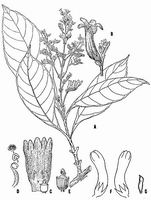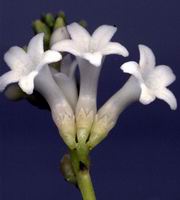

Left: Bunting & Duke, Ann. Missouri Bot.
Garden 48: 271, fig. 1 (1961), as Sanango durum
Right: cult. BG Vienna, phot. A. Sieder (2002).
Full name and orig. publication: Sanango Bunting & Duke, Ann. Missouri Bot. Gard. 48: 270 (1961).
Etymology: The name is the colloquial name furnished by the inigeneous collector of theplant. It is a corruption of a Quechuan word, “sanangu”, an Indian word also applied to other plants.
Synonyms: Gomara Ruiz & Pav. (1794), non Adans. (1763), Gomaria Spreng. (1831), Gomaranthus S.Rauschert (1982).
Position: See Notes.
Description: Small tree, c. 15 m tall, with very hard wood. Leaves opposite, petiolate, the margins joined accross the shoot axis, lamina elliptical to obovate, apex acute-acuminate, base attenuate. Inflorescence a terminal, bracteose thyrse; bracts and their axillary pair-flowered cymes opposite. Sepals connate in the lower part, narrow triangular, ± equal. Corolla tubular, tube curved and slightly gibbous in the lower part, limb subregular, lobes rounded, with cochlear aestivation in bud. Stamens 4, included, adnate to the corolla base; filaments inflated; anthers subglobose, introrse, versatile, dehiscent by a single, horseshoe-shaped line. Staminode present, small. Nectary cup-shaped, ± as high as the ovary. Ovary superior (wrongly referred to as semi-inferior in the recent literature), globose, slightly 4-partite; incompletely divided in the upper part, completely divided (with axile placentae) in the lower part; style very short; stigma capitate-bilobed, the lobes laterally joined with the style and directing downwards. Fruit a capsule, depressed at the apex, style (for a long time) persisting, dehiscence at first septicidal, then loculicidal.
Chromosome number: 2n = 32 (M. Kiehn, unpubl.).
Type and only species: Sanango durum Bunting & Duke, type = S. racemosum (Ruiz & Pav.) Barringer
Species names (incl. publication and synonyms): See Skog, L.E. & J.K. Boggan. 2005: World checklist of Gesneriaceae: http://persoon.si.edu/Gesneriaceae/Checklist.
Distribution: Peru (W central Amazonas and C Junin).
Ecology: In forests between 300 and 750 m altitude.
Notes: This enigmatic monotypic genus, previously placed in the families Loganiaceae, Buddlejaceae and Scrophulariaceae, was recently considered to belong to Gesneriaceae by some authors, who in a joint project investigated the genus in anatomical, chemical and molecular respects (Dickison 1994, Jensen 1994, Norman 1994, Wiehler 1994, Smith & al. 1994). The placement envisaged by Wiehler (tribe Gesnerieae), is weakly supported by the characters and requires confirmation. At present, Sanango is best classified as a genus of uncertain affinity, even the familial placement of which is uncertain.
Selected references: Dickison, Taxon 43: 601-618 (1994), fl. anat.; Jensen, Taxon 43: 619-623 (1994), pytochem.; Norman, Taxon 43: 591-600, anat.; Wiehler, Taxon 43: 625-632 (1994), syst., Smith et al., Taxon 46: 65-74 (1997), molec. syst.
Bibliography: See Skog, L.E. & J.K. Boggan. 2005. Bibliography of the Gesneriaceae. 2nd edition: http://persoon.si.edu/Gesneriaceae/Bibliography.
Illustrations:
 |
 |
Sanango racemosum (Ruiz & Pav.)
Barringer, only species
Left: Bunting & Duke, Ann. Missouri Bot.
Garden 48: 271, fig. 1 (1961), as Sanango durum |
last modified: 2007-07-13